Simulation Study on Performance Optimization of Magnetic Nanoparticles DC Thermometry Model
Abstract
1. Introduction
2. Model and Method
2.1. Langevin Model and DC Thermometry Model of MNPs
2.2. Temperature Sensitivity of the MNP Magnetization
2.3. Optimization of DC Thermometry Model of MNPs
3. Results and Discussion
3.1. Simulations of DC Thermometry without Hdc
3.2. Simulations of DC Thermometry with Hdc
3.3. Discussion
4. Conclusions
Author Contributions
Funding
Institutional Review Board Statement
Informed Consent Statement
Data Availability Statement
Conflicts of Interest
References
- Yang, J.M.; Yang, H.; Lin, L. Quantum dot nano thermometers reveal heterogeneous local thermogenesis in living cells. ACS Nano 2011, 5, 5067. [Google Scholar] [CrossRef]
- Adibzadeh, F.; Sümser, K.; Curto, S.; Yeo, D.T.B.; Paulides, M.M. Systematic review of pre-clinical and clinical devices for magnetic resonance-guided radiofrequency hyperthermia. Int. J. Hyperth. 2020, 37, 15–27. [Google Scholar] [CrossRef]
- Pi Ol, R.; Brites, C.D.S.; Bustamante, R.; Martínez, A.; Silva, N.J.O.; Murillo, J.L.; Cases, R.; Carrey, J.; Estepa, C.; Sosa, C. Joining Time-Resolved Thermometry and Magnetic-Induced Heating in a Single Nanoparticle Unveils Intriguing Thermal Properties. ACS Nano 2015, 9, 3134–3142. [Google Scholar]
- Winter, L.; Oberacker, E.; Paul, K.; Ji, Y.; Oezerdem, C.; Ghadjar, P.; Thieme, A.; Budach, V.; Wust, P.; Niendorf, T. Magnetic resonance thermometry: Methodology, pitfalls and practical solutions. Int. J. Hyperth. 2016, 32, 63–75. [Google Scholar] [CrossRef] [PubMed]
- Baron, P.; Deckers, R.; Knuttel, F.M.; Bartels, L.W. T1 and T2 temperature dependence of female human breast adipose tissue at 1.5 T: Groundwork for monitoring thermal therapies in the breast. NMR Biomed. 2015, 28, 1463–1470. [Google Scholar] [CrossRef]
- Cline, H.E.; Hynynen, K.; Watkins, R.D.; Adams, W.J.; Schenck, J.F.; Ettinger, R.H.; Freund, W.R.; Vetro, J.P.; Jolesz, F.A. Focused US system for MR imaging-guided tumor ablation. Radiology 1995, 194, 731–737. [Google Scholar] [CrossRef] [PubMed]
- Hynynen, K.; Darkazanli, A.; Unger, E.; Schenck, J.F. MRI-guided noninvasive ultrasound surgery. Med. Phys. 1993, 20, 107–115. [Google Scholar] [CrossRef] [PubMed]
- Zhou, Y.; Yan, D.; Yuan, S.; Chen, Y.; Fletcher, E.E.; Shi, H.; Han, B. Selective binding, magnetic separation and purification of histidine-tagged protein using biopolymer magnetic core-shell nanoparticles. Protn. Exp. Purif. 2017, 144, 5–11. [Google Scholar] [CrossRef]
- Tietze, R.; Zaloga, J.; Unterweger, H.; Lyer, S.; Alexiou, C. Magnetic Nanoparticle-based Drug Delivery for Cancer Therapy. Biochem. Biophy. Res. Commun. 2015, 468, 463–470. [Google Scholar] [CrossRef]
- Crespo, P.; Patricia, D.L.P.; Marín, P.; Multigner, M.; María Alonso, J.; Rivero, G.; Yndurain, F.; María González-Calbet, J.; Hernando, A. Magnetism in nanoparticles: Tuning properties with coatings. J. Phys. Condens. Matter 2013, 25, 484006. [Google Scholar] [CrossRef]
- Zhong, J.; Liu, W.; Jiang, L.; Yang, M.; Morais, P.C. Real-time magnetic nanothermometry: The use of magnetization of magnetic nanoparticles assessed under low frequency triangle-wave magnetic fields. Rev. Sci. Instrum. 2014, 85, 1783–2887. [Google Scholar] [CrossRef] [PubMed]
- Perreard, I.M.; Reeves, D.B.; Zhang, X.; Kuehlert, E.; Forauer, E.R.; Weaver, J.B. Temperature of the magnetic nanoparticle microenvironment: Estimation from relaxation times. Phys. Med. Biol. 2014, 59, 1109. [Google Scholar] [CrossRef]
- Weaver, J.B.; Rauwerdink, A.M.; Hansen, E.W. Magnetic nanoparticle temperature estimation. Med. Phys. 2009, 36, 1822. [Google Scholar] [CrossRef]
- Rauwerdink, A.M.; Hansen, E.W.; Weaver, J.B. Nanoparticle temperature estimation in combined ac and dc magnetic fields. Phys. Med. Biol. 2009, 54, L51. [Google Scholar] [CrossRef]
- Zhang, Y.; Guo, S.; Zhang, P.; Zhong, J.; Liu, W. Iron oxide magnetic nanoparticles based low-field MR thermometry. Nanotechnology 2020, 31, 345101. [Google Scholar] [CrossRef]
- Chikazumi, S.; Taketomi, S.; Ukita, M.; Mizukami, M.; Miyajima, H.; Setogawa, M.; Kurihara, Y. Physics of magnetic fluids. J. Magn. Magn. Mater. 1987, 65, 245–251. [Google Scholar] [CrossRef]
- Kaiser, R. Magnetic Properties of Stable Dispersions of Subdomain Magnetite Particles. J. Appl. Phys. 1970, 41, 1064–1072. [Google Scholar] [CrossRef]
- He, L.; Liu, W.; Xie, Q.; Pi, S.; Morais, P.C. A fast and remote magnetonanothermometry for a liquid environment. Meas. Sci. Technol. 2016, 27, 25901. [Google Scholar] [CrossRef]
- Hauser, M.; Kraus, L.; Ripka, P. Giant magnetoimpedance sensors. IEEE Instrum. Meas. Mag. 2001, 4, 28–32. [Google Scholar] [CrossRef]
- Herrero-Gomez, C.; Marin, P.; Hernando, A. Bias free magnetomechanical coupling on magnetic microwires for sensing applications. Appl. Phys. Lett. 2013, 103, 218–222. [Google Scholar] [CrossRef]
- Moré, J.J. The Levenberg-Marquardt Algorithm: Implementation and Theory. In Numerical Analysis; Springer: Berlin/Heidelberg, Germany, 1978; pp. 105–116. [Google Scholar]
- Lak, A.; Ludwig, F.; Scholtyssek, J.M.; Dieckhoff, J.; Fiege, K.; Schilling, M. Size Distribution and Magnetization Optimization of Single-Core Iron Oxide Nanoparticles by Exploiting Design of Experiment Methodology. IEEE Trans. Magn. 2013, 49, 201–207. [Google Scholar] [CrossRef]
- Della Torre, E.; Bennett, L.H.; Watson, R.E. Extension of the BLOCH T(3/2) law to magnetic nanostructures: Bose-Einstein condensation. Phys. Rev. Lett. 2005, 94, 147210. [Google Scholar] [CrossRef] [PubMed]
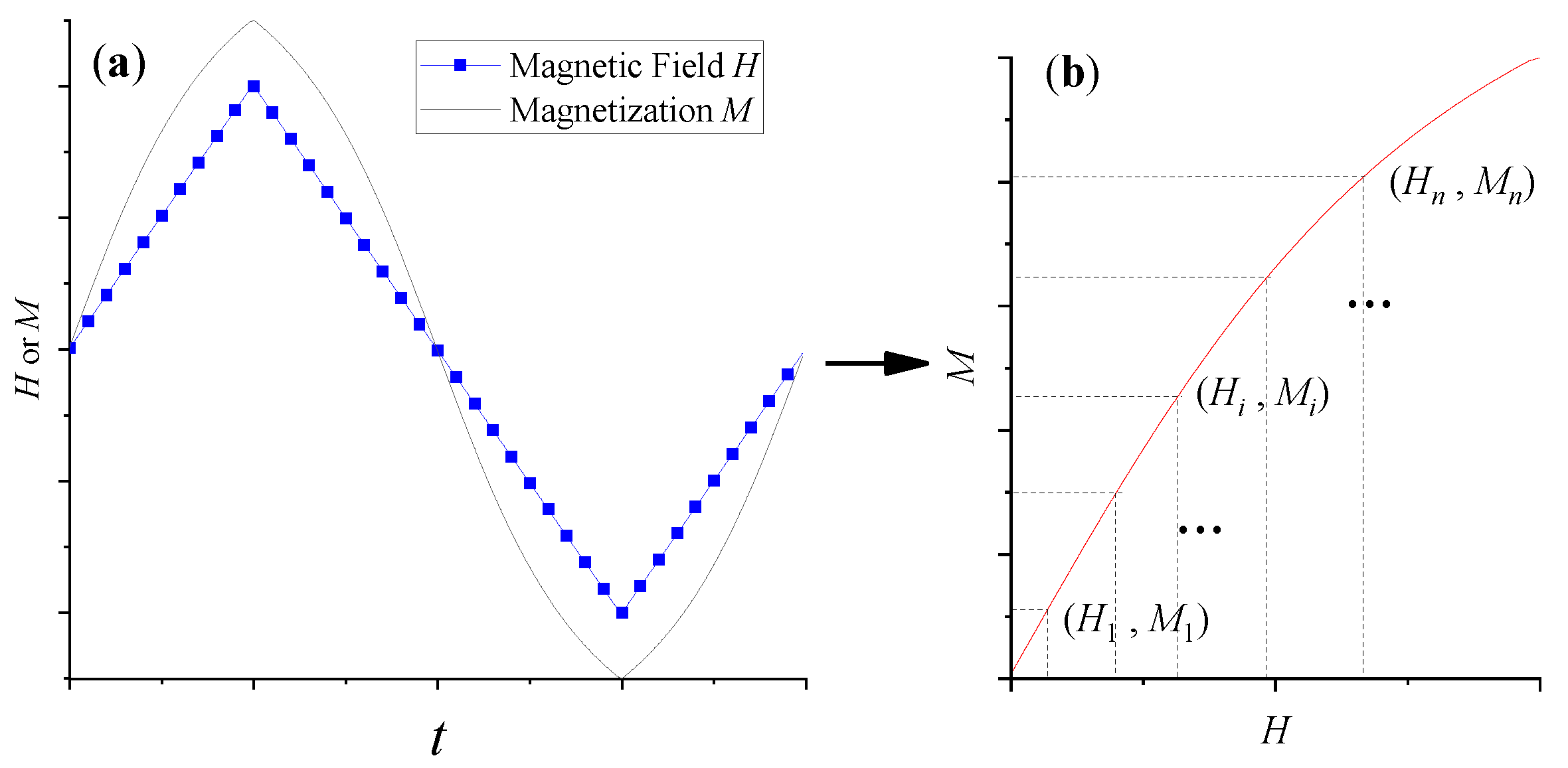


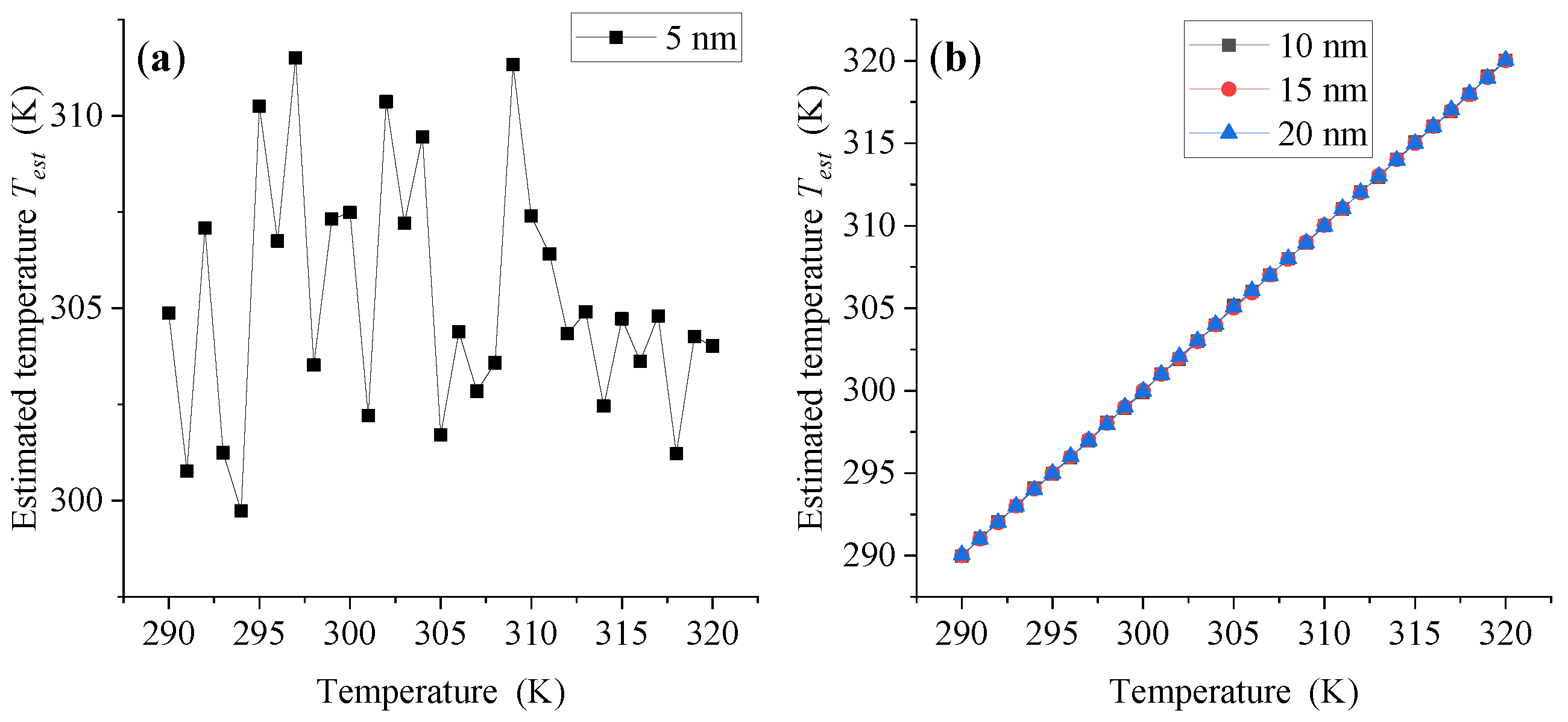

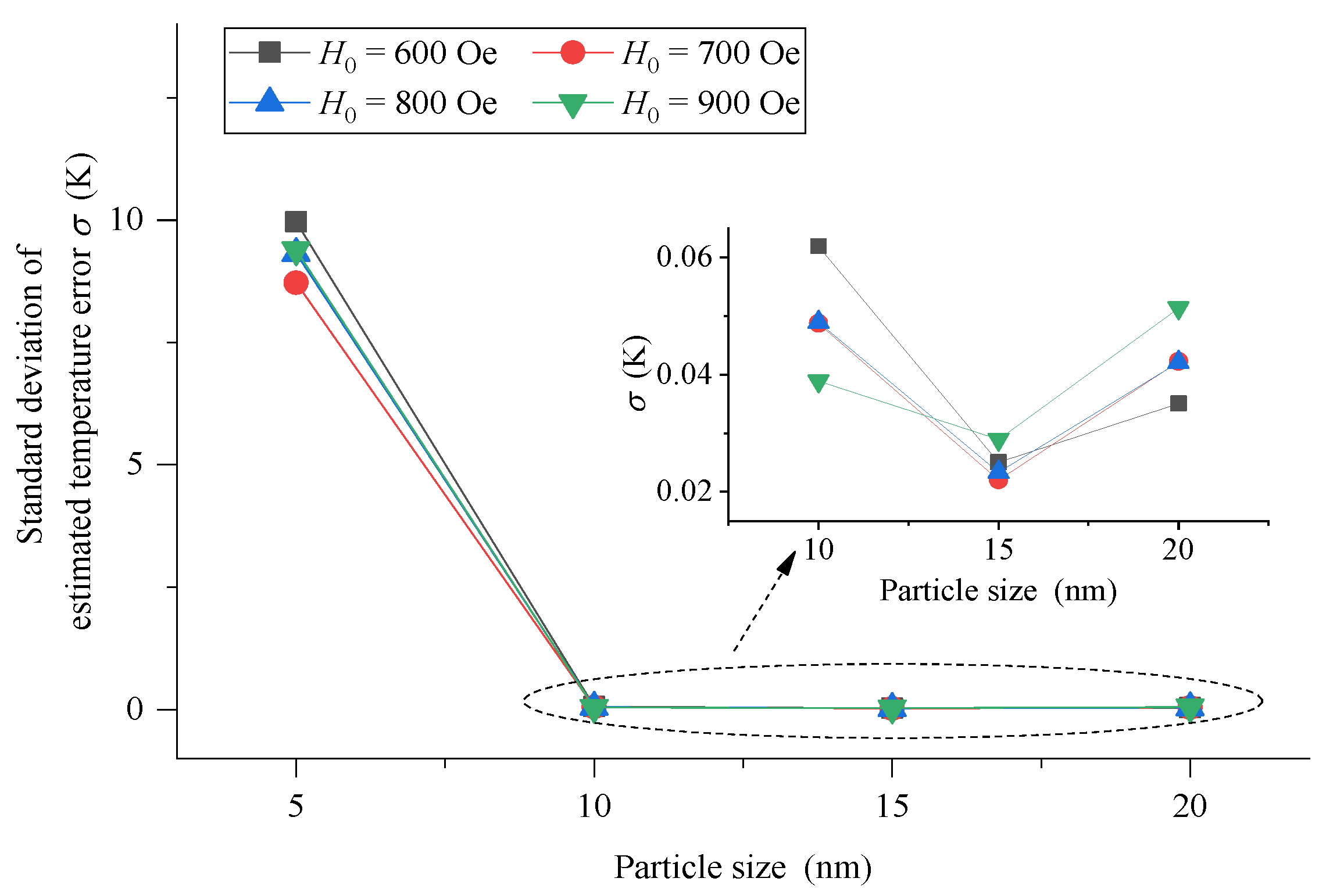
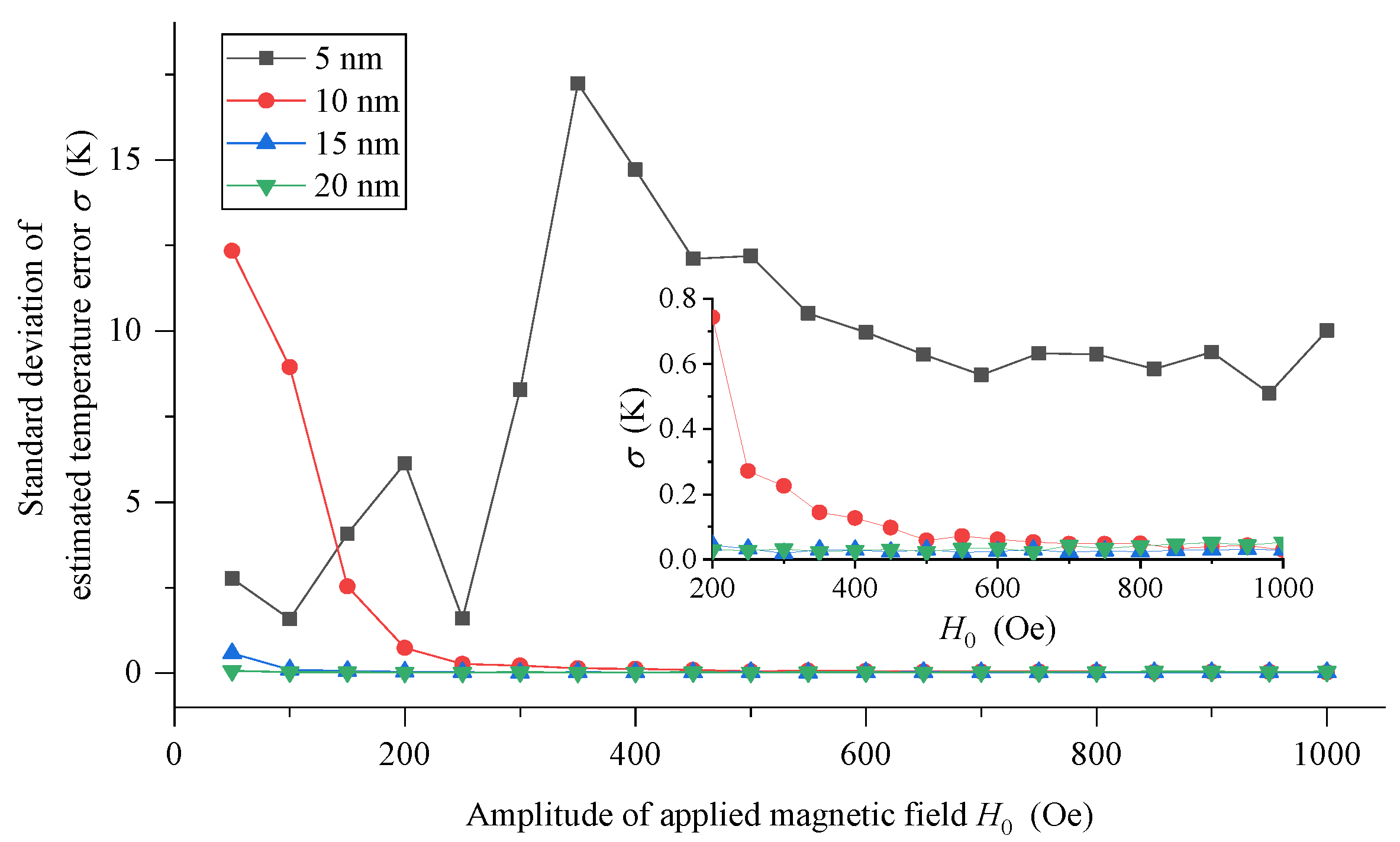
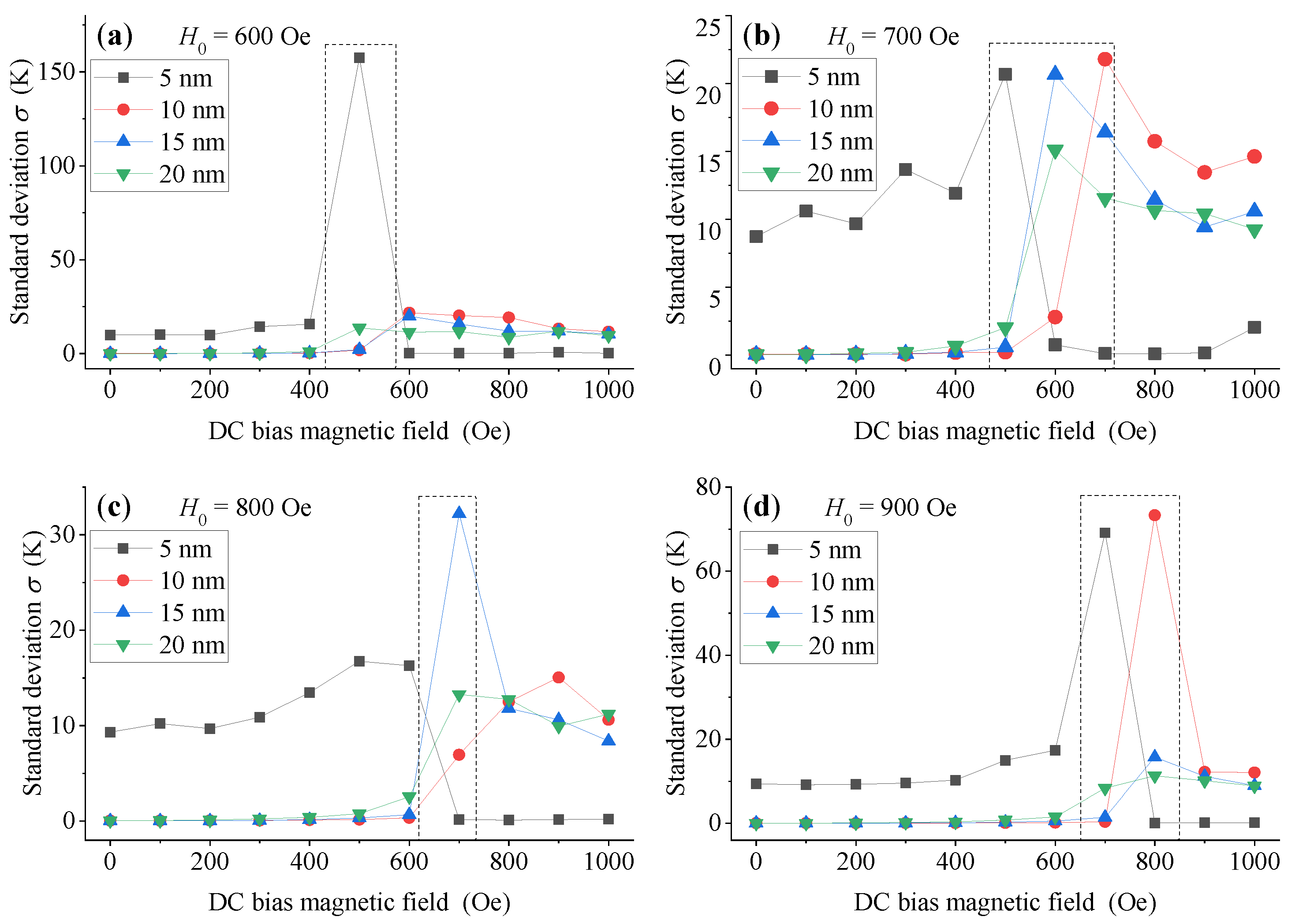

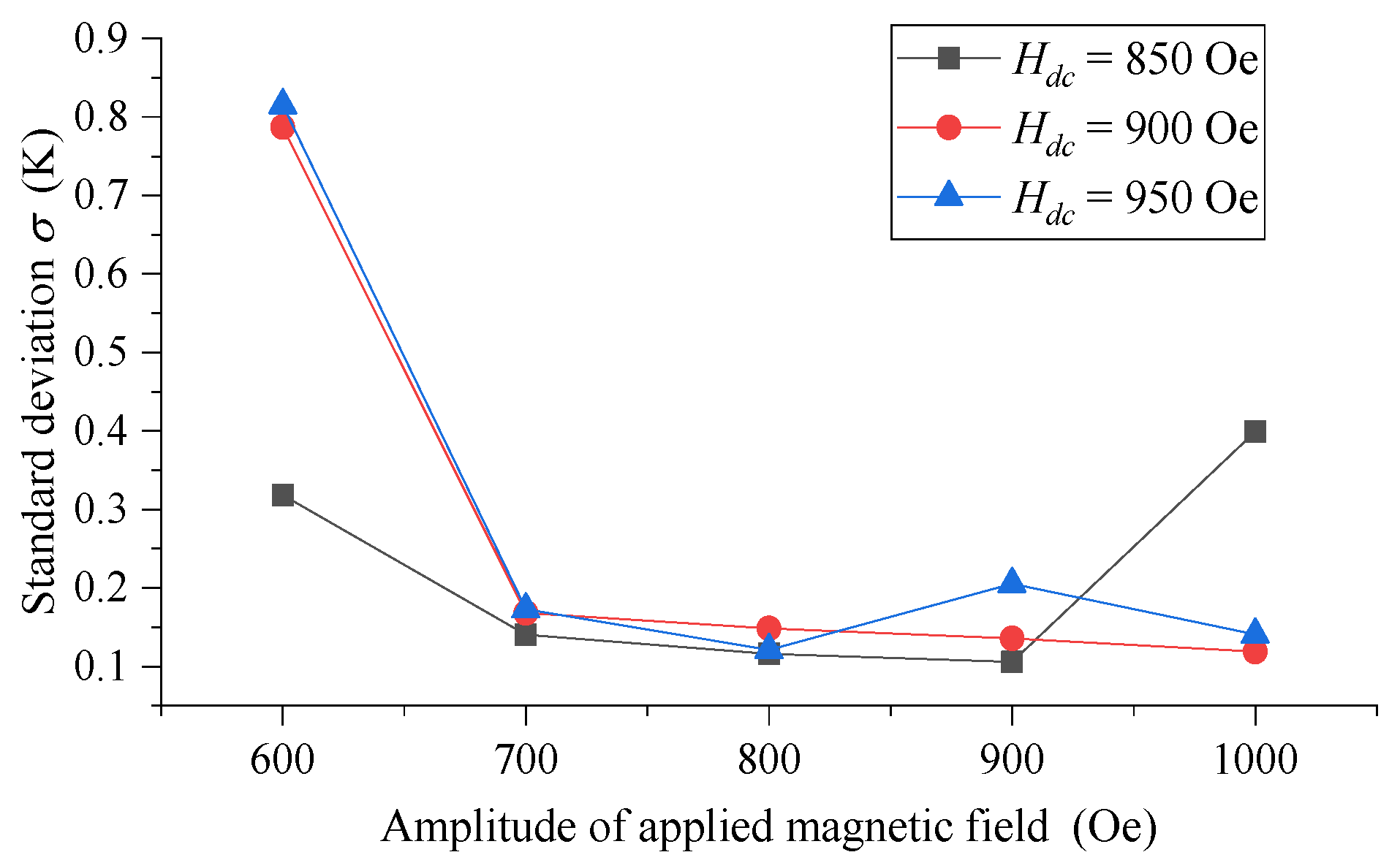
Publisher’s Note: MDPI stays neutral with regard to jurisdictional claims in published maps and institutional affiliations. |
© 2021 by the authors. Licensee MDPI, Basel, Switzerland. This article is an open access article distributed under the terms and conditions of the Creative Commons Attribution (CC BY) license (https://creativecommons.org/licenses/by/4.0/).
Share and Cite
Zhang, Y.; Ma, S.; Liu, W. Simulation Study on Performance Optimization of Magnetic Nanoparticles DC Thermometry Model. Sensors 2021, 21, 2404. https://doi.org/10.3390/s21072404
Zhang Y, Ma S, Liu W. Simulation Study on Performance Optimization of Magnetic Nanoparticles DC Thermometry Model. Sensors. 2021; 21(7):2404. https://doi.org/10.3390/s21072404
Chicago/Turabian StyleZhang, Yapeng, Shuangbao Ma, and Wenzhong Liu. 2021. "Simulation Study on Performance Optimization of Magnetic Nanoparticles DC Thermometry Model" Sensors 21, no. 7: 2404. https://doi.org/10.3390/s21072404
APA StyleZhang, Y., Ma, S., & Liu, W. (2021). Simulation Study on Performance Optimization of Magnetic Nanoparticles DC Thermometry Model. Sensors, 21(7), 2404. https://doi.org/10.3390/s21072404





